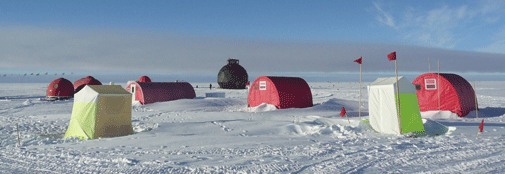Keeping the ice core cold

Midnight after a beautiful summer day
Summer has come to NEEM and we enjoy the lovely weather drinking coffee outside or taking a hike. The warm summer temperatures do, however, have a major drawback for our project: The trenches where ice cores are drilled and processes are heating up and the ice is getting too warm. Certainly the ice is not melting, but when temperatures are approaching -10 °C or so, certain physical properties of the ice begin to change relatively fast.
The main issue is the gasses in the ice which start to diffuse out of the ice core when they are stored in a too warm environment for too long. To counteract this problem cooling tunnels are dug onto the sides of the trenches from which cold air from the surrounding firn is sucked in. The irony about it is that the currently drilled ice is actually rather warm down in the ice sheet. That's due to the geothermal heat that brings the basal ice close to the pressure melting point. Within the ice sheet, however, the gasses can of course not escape even if it is varm. To make things complicated, the ice core is actually rather cold when it is taken out of the drill. That is because the drill is passing though the ice from the last glacial period which is still preserving the cold temperatures.
A solution to the problem would be to have active cooling of the trenches. Somehow, however, it just doesn't seem right to install a deep freezer in the middle of the Greenland ice sheet.
What we have done today:
1. Drilling and core logging ice. Driller's depth: 2320.44 m.
2. Processed deep ice cores. 22.55 m. Final depth 2275.90 m.
3. CFA measurements. 17.60 m. Final depth: 1895.85 m.
Ad. 1: Drillers report, Thursday 1-7-2010.
Since last Sunday the drilling has been quite stable, most runs deliver 3 m to 3.5 m long cores. The drilling current is typical from 8 amp to 10 amp, the pitch is typical 2.7 mm, the inclination is slightly increasing, being 4.4 deg now in spite of 5 kg to 8 kg negative cutter load. Having increased the strength of the pump springs by 50% on the one piece shaft reduced the current by 1.5 amp. The core breaks have mainly been from 1400 kg to 1600 kg, slight modification on the core dogs seems to have lowered the breaks down to 1100 kg.
A few runs have been troubled by not recovering the core (even by the core dogs groowing through the entire core), by disengaged pump and computer break down. All problems have been taken care of. The stable drilling is clearly due to moving the center rings from the middle of the hollow shafts up 1.3 m which gives 4.5 m free space for the chips. The 1.1 m long upper part of the chips chamber is chips free after each run. It might be a good option to remove the upper rings at all. The chips recovery is from 19 kg to 23 kg per standard run.
The chips are quite coarse in the large crystal Eemian ice. Daily production has been around 17 m.
Drillers Trevor, HC and Roman left camp Thursday.
Drillers (Sigfus, Steff (drill mechanic),Torbjorn, Seb, JiWong, Olivier and Fernando).
Weather: Beautiful day with clear blue sky, low winds from SE and temperatures -18 °C to -7 °C.
Assisting FL, Anders Svensson
| ← Previous entry | Next entry → |

